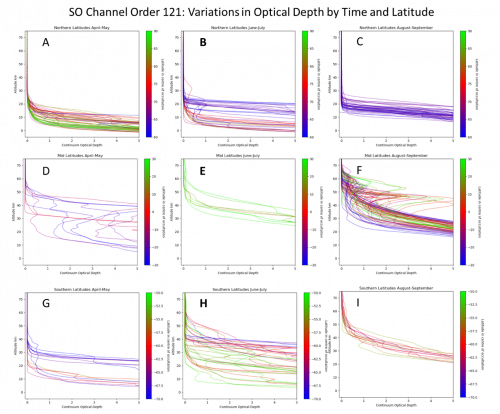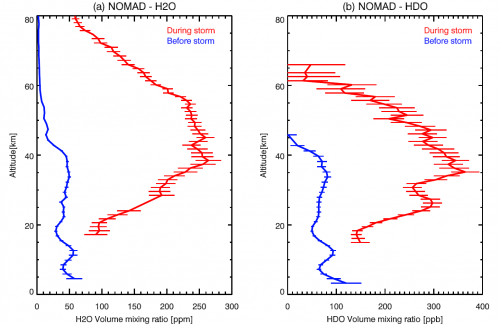Start of the science phase
The ExoMars Trace Gas Orbiter (TGO) arrived at Mars in October 2016. After more than one year of aerobraking to slow down the spacecraft and bring it to the correct orbit, instruments on TGO were awoken and tested to check their capabilities. All instruments started their first science observations in April 2018, just before the beginning of the 2018 global dust storm.
Dust storm observations
The NOMAD instrument was designed specifically to detect and measure gases in the atmosphere of Mars, and so witnessed the onset and developments of this global dust storm and its impact on water abundance in the Martian atmosphere.
The 2018 dust storm started near the Northern autumn equinox (Ls~185°) and within a few weeks the lower atmosphere of the planet was full of atmospheric dust. The presence of dust and/or cloud layers causes local increases in optical depth, with the effect being most pronounced at mid-latitudes close to the equator (Figure 1, D-F).
Even before the dust storm, many layers were observed up to 40 km above the surface (D, G); but after 1 June, more features at 20-35 km altitude were observed that were not present before (E-F, H-I).
Water on Mars
NOMAD measured water vertical profiles, and for the first time, the vertical profile of HDO could also be observed in the Martian atmosphere.
Water profiles, both H2O and HDO, show a large enhancement in the middle atmosphere after the onset of the dust storm. The increase in water abundance is observed above 20 km, with water vapour being lifted upwards up to 90 km (Figure 2).
What about methane?
NOMAD has performed, and continues to perform, a thorough search for methane in both nadir and solar occultation measurements.
Up to now, no clear signature has been found, however NOMAD is very sensitive to even trace amounts of methane - and so we can infer upper limits on the amount of methane present in the atmosphere across the whole planet.


